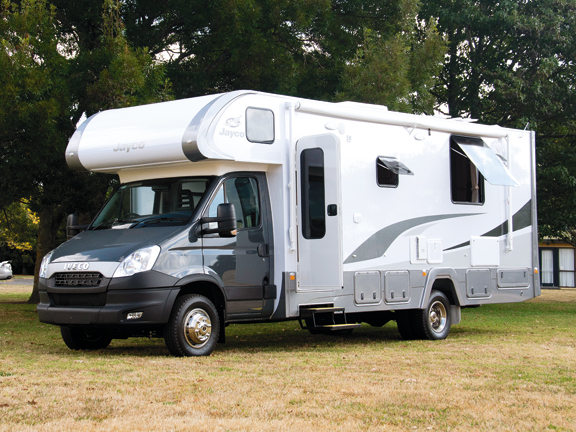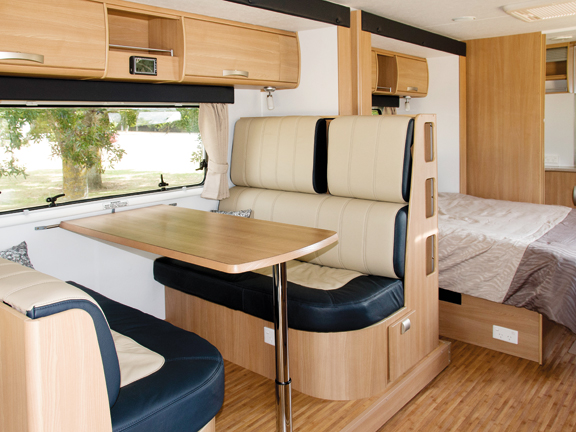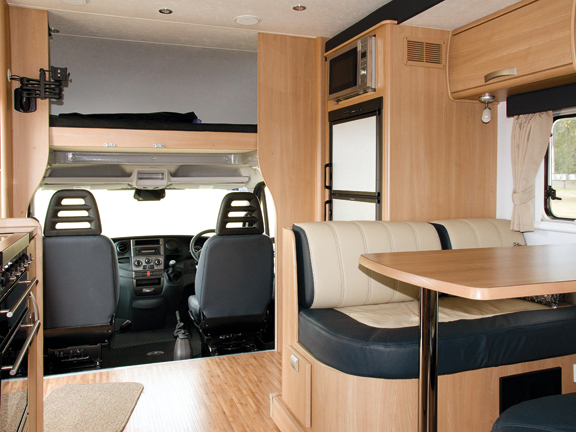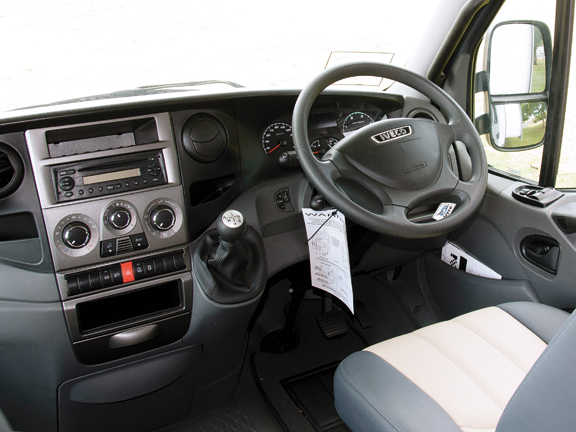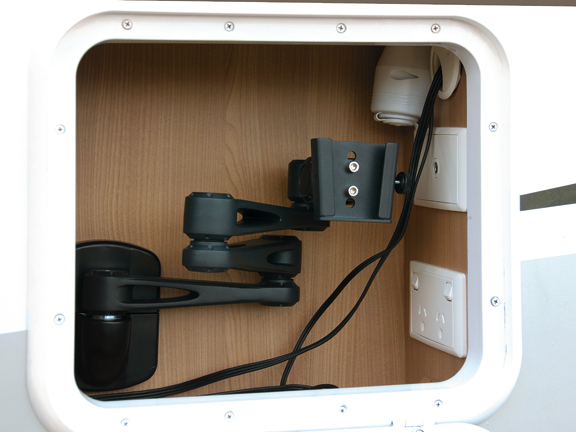My first impression of this new Jayco Optimum was a practical, no-nonsense workhorse ready for action. Sitting in South Auckland Caravan's yard among the Jayco Conquests, it stands head and shoulders above them. Built on the Iveco Daily Series IV.28-1, it is the biggest motorhome Jayco have built to date. It is longer, higher, and heavier than any Jayco gone before and with its rear-wheel-drive, this Optima can tow more too - up to 3000kg. If this is not enough, it has not one but two slide-out modules, one in the lounge and another in the bedroom.
The Optimum floor-line is quite high off the ground providing good ground clearance for country roads and remote freedom camping spots. The body roofline is level with the top of the Luton front so the coachwork retains a pleasingly-balanced appearance. It doesn't look too high. The space below the floor-line of the Optimum is put to good use. There are three large lockers on each side, plus a slide-out BBQ on the kerbside, and an LPG locker on the offside. It has a full suite of externally-mounted equipment included in the standard specification: a fold-down table, an entertainment centre for TV and audio, a five-metre-long Carefree electric-powered awning, a 120 amp solar panel, a Winegard terrestrial TV aerial, and a Satellite TV aerial; while the bike rack and towbar fitted to the vehicle reviewed are optional extras. From now on this model Optima will include as standard a 2.3kVa Onan generator.
To drive this Jayco Optimum Iveco Daily Series IV.28-1 you will need a Class 2 licence. If you are new to driving large motorhomes you'll likely find the Iveco Daily to be much less daunting than a cab-over-engine truck. The cab seats, leather-clad to match the dinette seats, have an excellent range of adjustment. Whether you are short or tall, slim or cuddly, all the controls readily come to hand and you have an excellent view of the road ahead and behind, courtesy of the large rearview mirrors and the rearview LCD display. The automated manual transmission (AMT) provides both automatic and manual driving modes. Being able to manually select your preferred gear ratio travelling down steep hills provides good vehicle control while auto is a good choice while learning how to handle a larger new vehicle.
The Optimum has an open plan layout typical of Kiwi/Australian motorhomes. Climb four steps, and go through the entry door into the lounge/kitchen. To the left, over the cab, is a spacious double bed - a very handy place for putting hats, coats, cameras and bags while touring. Aft of the kitchen/lounge is the bedroom area and then the bathroom stretches across the rear of the motorhome.
The slide-out modules can be deployed separately, but usually are both opened out at the same time. Open they create more interior width - each slides out 480mm - but it is in the lounge the extra space is more obvious. Here, the dinette and fridge/freezer in the larger slide-out module move away from the kitchen bench changing 'corridor space' into 'room space'. The slide-out mechanism is new, with four separate electric motors used to move the module, rather than the threaded screw system used previously. With the slide-out closed there is still enough room to walk between the kitchen and dinette without barking your shins. The bedroom slide-out is not so effective. In the open position it is fine, but in the closed (travelling) position the foot of the bed is quite close to the cabinetry on the kerbside wall. Not so convenient if you want to use the toilet while travelling. However, the Optimum can be ordered without this kerbside furniture if you wish. There is so much other storage available anyway, this would be my choice.
The contemporarily-styled interior is quiet and restful. Leather upholstery cushions in cream and charcoal add a note of contrast with the honey-coloured laminate surfaces. Overall, the effect is pleasing to the eye. Dinette seats in RVs are often quite uncomfortable but these are surprisingly supportive with just the right amount of rake on the back cushions. The two forward facing dinette seats are fitted with seat belts for two passengers. Interior lighting is almost exclusively LED and there is plenty of it. To ensure the lights stay on there are two x 100A/hr batteries supported by a Setek 35 amp converter/charger augmented by the 120-watt solar power panel operating via a 30-amp regulator - not forgetting the 2.3kVa Onan generator should all else fail! For your audio/visual stimulation, Jayco include a 46cm LED TV and CD player as standard equipment. All the windows are double-glazed with fitted blinds and insect screens. There are two 500mm x 700mm Dometic roof hatches for ventilation, and if it becomes too hot or cold the Ibis heat pump can deal with that, too.
In keeping with current trends, the Optimum kitchen cabinetry has wide drawers with stylishly curved fronts. They are practical too. As well as accommodating longer items, you can see at a glance where things are. I like them. The Smev oven has a separate grill - three gas hobs and one electric, and a rangehood above to deal with cooking steam and odours. Under the bench is a small slide-out pantry. Bench space is adequate for food preparation and there is room aplenty for food and beverage storage. A 186-litre Dometic fridge/freezer is housed beside the dinette in the slide-out and has a microwave located above it. Overall, a practical kitchen designed for one or two people to prepare meals with little fuss or inconvenience.
The 'east-west' permanently made-up double bed has its own slide-out module. Once the module is open the bed-base must be pulled away from the wall and a bolster (supplied) inserted into the gap to obtain the full bed length. With the bed opened out to full length there is access past the foot of the bed, but it is tight - another reason for electing not to fit the kerbside furniture. Once the bed is set up, the pillow-top inner-sprung mattress over slat-base promises night-long comfort. The bed-base lifts (gas-strut assisted) to access the storage beneath. Clothes and other personal possessions can be stored in the hanging locker and drawers at the end of the kitchen bench and the overhead lockers above the bed head. There are more overhead lockers above the kitchen bench and dinette, and drawers and storage under the dinette seats.
Like many imported RVs, the bathroom in the Optimum is superb. Lots of room and very well-appointed with a residential-sized shower and vanity unit, it caters to all shapes and sizes. Tucked in the corner under the vanity top is a Sphere washing machine to deal to the discarded training kit. In the Optimum's land of origin, Australia, most RVers with good bathroom set-ups like this in the Optimum tend to use their own, rather than the park's, facilities. After all, most park sites have mains pressure water and the grey water goes straight into an on-site drain, so why not use your own facilities? If you are freedom camping, there is a 240-litre fresh-water tank to draw from, but only 80 litres of grey-water tankage. This small tank size reflects Australia's less stringent requirements concerning the disposal of grey water.
I think Jayco have made a credible entry into the motorhome big league with the Optimum built on the Iveco Daily Series. The Daily has all the sought after trappings, ABS braking, traction and stability control, keyless central locking, aircon and cruise control. Its towing capacity is up to 3000kg and, with rear-wheel-drive, makes it a serious contender for owners wanting to tow boats, cars and trailers. Jayco have fitted as standard many items other suppliers offer as extras. All this comes in a package currently retailing at $NZ230,000, incl GST.
For more information contact Glenn O'Donnell or Mark Rhodes at South Auckland Caravans, on 09 298 7873 or visit jayco.com.au.
Feel free to make a comment or ask us a question about this story on the MCD  page.
For the latest reviews, subscribe to our Motorhomes, Caravans & Destinations magazine here.
page.
For the latest reviews, subscribe to our Motorhomes, Caravans & Destinations magazine here.
 page.
For the latest reviews, subscribe to our Motorhomes, Caravans & Destinations magazine here.
page.
For the latest reviews, subscribe to our Motorhomes, Caravans & Destinations magazine here. 
